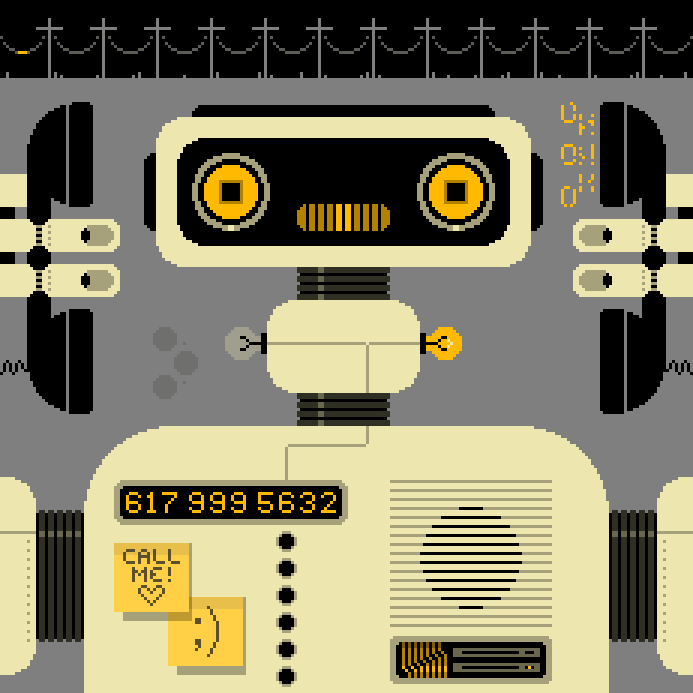Scientific methods currently existed seem to be not enough to explain all phenomena happening in this crazy world.
How to explain that a toast falls butter-side down in the majority of instances (from a designer’s hand, actually, in all)? Why does a presentation kit break a second before a demonstration to a client? Why users complain about a crappy logotype and do not appreciate a titanic work on a website redesign in general? Where is the justice and who is in fault?
In order to systemize the world mess, specialists from various fields formulate their own rules of thumb which are successfully applied to web design as well. I’ve selected a dozen of the most notable and explained how they work on examples.
1. Murphy’s Law
"If there are two or more ways to do something, and one of those ways can result in a catastrophe, then someone will do it."

Murphy’s law is also known as Finagle’s law or Toast’s law. The concept may be as old as humanity, but the term actually occurred in 1949. The law namesake was Capt. Ed Murphy, a development engineer at the United States Air Force. When working on a project to determine a maximum overload a human being is able to endure, Murphy stated that the technicians could bungle wherever possible. According to a legend, he first noted this when saw that all 16 sensors attached to a test subject were set arsy-versy: from only two possible ways to do this, the wrong way was chosen.
One of the many consequences of Murphy’s law, known as Pauli effect, states that in a presence of certain people, any technical equipment breaks down. Remember those terrible moments when a flawless project presentation suddenly turns into a nightmare right before the eyes of a client?
If a creative concept is presented to a client, it necessarily fails. And the more a demonstrator is interested in a success, the bigger a failure will be.
Murphy’s law explains a lot and nothing at the same time. Moreover, it rather approved the fact that there is a devil’s curse imposed on all of us. The good news is that we at least can be prepared to a failure at the wrong moments, at least morally. So stock up additional presentational boards, back up important files, and prepare for the worst. Then, the success will be a nice surprise.
2. Occam’s Razor
"Entities must not be multiplied beyond necessity."

And, as an English Franciscan friar, William of Ockham, continued, for each accepted explanation of a phenomenon, there may be an extremely large, perhaps even incomprehensible, number of possible and more complex alternatives, but the one with the fewest assumptions should be selected.
But what the heck does Occam’s Razor have to do with web design? I’m glad you asked. To put it plainly, the simplest explanation is usually the best. For example, if your client is late to a meeting, you would likely to assume he/she got stuck in traffic rather that got abducted by aliens and had to fight through an endless maze of green monsters to get to the meeting on time, wouldn’t you?
Finding the simplest solution is not as easy as it may seem. Complicating things is actually a human nature and a scourge of many web designers. An idea of a creative industry looks so magnetic, especially to newbies.
But following Occam’s Razor, unnecessary elements that would decrease a design’s efficiency should be eliminated. So, when two elements have the same function, this rule of thumb recommends selecting the simpler.
3. Hanlon’s Razor
"Never attribute to malice that which is adequately explained by stupidity."

The quote belongs to Robert J. Halnon who used it as a submission for a book compilation of various jokes related to Murphy’s law published in 1980. The submission was created by an analogy with Occam’s razor.
British have their own variation of this law: “Cock-up before conspiracy.” An author of this words is Bernard Ingham, Margaret Thatcher’s chief press secretary. He argued that while many journalists have fallen for the conspiracy theory of the government, he believed “they would produce more accurate work if they adhered to the cock-up theory.” Later, this expression became a basis for a law.
So applying this rule to web design, when you see an accomplished project is crappy, with a number of shortcomings, do not think that it is that because a designer or agency want to fool you and make a quick buck. Most likely, you chose an amateurish contractor or that is actually you who are a bad client.
4. Parkinson’s Law
"Work expands so as to fill the time available for its completion."

In other words, if something must be done in a year, it will be done in a year. If it must be done in 5 months, then it will. If you allocate two weeks for completing a task that can be done in 2 days, the task becomes more complicated, just to fill the allotted week. On the other hand, although it may sound weird, as the length of time allocated to a task became shorter, the task became easier to solve.
Cyril Parkinson, a British historian, first observed this phenomenon during his time with the British Civil Service. He found that as bureaucracies expanded, employees became more inefficient.
This rule of thumb is often, as for me, wrongly interpreted in a sense to mean that we tend to procrastinate and drag out tasks to fill an arbitrary work day. But to Parkinson, the adage was meant to show that growth of large bureaucratic organizations can be unrelated to work.
The catch is that such misinterpretations do not take into account how people procrastinate. This makes sense if to think that we, designers, do not actually expand the work we do, we just put it off and do other stuff that fills the time that would fall to the bottom of the priority list if we had stricter limitations.
5. Gates’ Law
“The speed of software halves every 18 months.”*

A humorous remark of Microsoft founder, Bill Gates, is a variation of a Wirth’s law, stating that software is getting slower more rapidly than hardware becomes faster. Bill Gates said that the reasons for this regularity are elementary: adding of unnecessary functions, slovenly written code, unwillingness to refine programs, poor management, and frequent team changes.
While Gates said about commercial software, the similar can be applied to websites as well.
The average website lifespan in today’s digital world is an average 3 years, and the trend shows that it is likely to decrease further still. Abundant or unnecessary elements and functions implemented into your website shorten its lifetime.
6. 1% Rule
“Only 1% of the users of a website actively create new content, while the other 99% of the participants only lurk.”

I like an 89:10:1 proportion more. Let’s assume that you created a blog on your restaurant website which got a group of 100 people online. Then, according to the 1% rule, one will create content, 10 will somehow interact with it (commenting, sharing, and so on), and the other 89 will just view it.
Consider some statistics from that other community content generation project, Wikipedia: a half of all Wikipedia article edits are done by less than 1% of users, and 70% of all articles have been written by 2% of all users.
Take this into account when creating a blog on your website.
7. Pareto Principle (The 80/20 Rule)
“For many events, roughly 80% of the effects come from 20% of the causes.”

In 1896, Vilfredo Pareto found that the approximately 80% of the land in Italy was owned by 20% of the population. Then, he tried to apply his finding to other phenomena and observed that about 20% of the peapods in his garden contained 80% of the peas. Indeed, why go far?
In his book The 80/20 Principle: The Secret to Achieving More with Less, Richard Koch added principal sequences to Pareto principle by saying that most actions are actually a waste of time. There are a great number of vital factors, but there are even a greater number of trivial ones. Only a few things work fantastically well and have a tremendous impact while the most of what exists in the universe have little value and yield little results.
Around 80% of your sales are generated by 20% of your customers. 20% of bugs are responsible for 80% of the crashes. 20% of your employees bring 80% of results to your business. This list goes on.
Diving deeper, you will see that, if 80% of your achievement comes from 20% of your effort, then, 80% of that 80% also comes from 20% of that initial 20%. In other words, 4% of your effort account for 64% of the results. Don’t be scared, it is just a pure math.
So, it appears that the most important, successful, rewarding, and productive accomplishments in our lives come from a fraction of a time we put it on.
Let’s assume that achieving a team-leading level takes 10 years of a dedicated training. Thus, according to Pareto rule, one may become a senior for just 2 years of those 10. Continuing this thought, we can assume that for the same 10 years, one may either to become a team lead or to master up to 5 intersecting specializations.
In the modern, constantly changing the world of technologies, where most jobs require knowledge of a few fields, polymaths - strong in communication, emotionally intelligent, and able to connect dots between their own fields and the real world - oftentimes win deep subject-matter experts.
The one characteristic that unites all movers of the world is an insatiable need to learn as more as possible on varying topics. They see how to fold incompatible at the first sight things into a single puzzle. Applying the 80/20 rule to their lives, they emerge as business, social, political leaders.
8. Von Restorff Effect
“When multiple homogenous stimuli are presented, the stimulus that differs from the rest is more likely to be remembered.”

The Von Restorff effect is a cognitive bias in favor of remembering the unusual identified by Hedwig Von Restorff in 1933. After conducting a set of memory experiments around isolated and distinctive items, she concluded that an unusual, in a list of otherwise similar items, would be better remembered than an item in the same relative position in a list where all items were similar.
Differences in experience occur when some event stand out from others. For instance, people often remember important events of their lives, such as the first day in a college or at new work. Unique faces and strange words are always remembered better than ordinary ones.
That’s why unique brands, unusual packaging, emotional advertising campaigns can increase brand recognition and sales, as the shift from the norm gets attention and is more likely to be remembered.
When it comes to web design, it is all about choice: what color to choose, what fort type to pick, which concept idea is more catchy and precise. These choices ultimately influence the message a designer tries to get across. While there are certain basic rules and templates that designers can fall back on, creating a unique website often comes down to a designer’s own taste and vision. And sometimes, this vision is not correlated with a client’s and thus become the source of much friction and ego-bruising on either side. You as a client can be inspired or, vice versa, dissatisfied with something, but always keep in mind a whole picture.
9. KISS Principle ("Keep it simple, stupid")
“Most systems work best if they are kept simple rather than made complicated.”

The KISS principle is about striving for simplicity. It somehow echoes Occam’s razor. Some people interpret it in their own way by reading it as “Keep it simple stupid.” You can choose what you like.
Modern programming languages, frameworks, and APIs have powerful means to produce sophisticated solutions for various kinds of problems. Developers often feel tempted to develop “clever” solutions. The KISS principle states that the less polymorphism, inheritance, and stuff like that are, the better solution is.
Good UX/UI designers know that the good interface is an invisible interface. Hidden interfaces sometimes referred to as “zero UI,” are a hot topic in the design community. And for good reason. Interfaces actually get in the way. We do not want to focus on an interface. We want to focus on the content a website provides. We do not want to think of ourselves as using a smartphone, we want to think of ourselves as doing what we want.
By focusing on the experience and not the interface, you will ensure that your users remain at the core of your mission. And whatever you implement will make their lives better and easier.
Hope, this article was entertaining for you. If you are interested in learning more about web development process and costs of websites, want a little web design inspiration or are looking for some tips and tricks on how to find a good web agency, check our blog regularly - we have a lot of tasty things to share with you.
Reach out to us, if you have an idea of creating your own website in mind - Vintage knows how to bring cool ideas into life!

View Comments